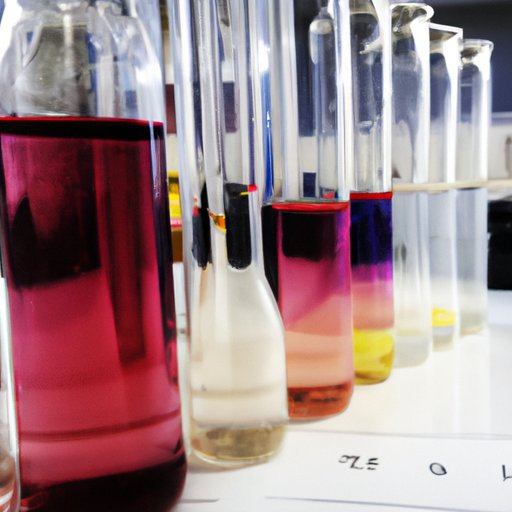Introduction
The term pH is a measure of acidity or alkalinity in a solution that is used to determine the concentration of hydrogen ions. It is an important concept in science, as it provides insight into many different biological, chemical, and physical processes. This article will explore what is pH in science and its role in scientific research.
Exploring the Meaning and Significance of pH in Science
What is pH and why is it important? The pH scale measures how acidic or basic a solution is by determining the concentration of hydrogen ions present in the solution. A neutral pH (7.0) indicates that the solution has equal amounts of hydrogen ions and hydroxide ions. A lower pH indicates a more acidic solution, while a higher pH indicates a more basic solution. The pH scale runs from 0 to 14, with 7 being neutral.
How does pH impact biological, chemical, and physical processes? The pH of a solution can have an effect on the solubility of certain compounds, the rate of chemical reactions, and the activity of enzymes. In addition, pH plays an important role in aquatic environments, as it affects the survival of aquatic organisms. For example, some species of fish prefer slightly acidic water, while others prefer slightly basic water. Thus, understanding pH is essential for studying aquatic ecosystems.

A Primer on pH: What it is and How it Affects Science
Definition of pH and its measurement. pH is measured using a pH meter or a pH indicator, which are devices that measure the concentration of hydrogen ions in a solution. The resulting reading is then compared to a reference standard to calculate the pH of the solution.
Examples of pH levels in different environments. The pH of different environments varies greatly. For instance, the pH of rain and snow is approximately 5.6, while the pH of seawater is typically 8.1-8.4. The pH of soil can range from 3.5 to 8.5, depending on the type of soil and the amount of organic matter present. Additionally, the pH of the human body can vary between 4.5 and 8.0, depending on the location and the individual’s health.

Investigating the Role of pH in Scientific Research
Exploring the use of pH in laboratory experiments. Scientists often use pH as a variable in laboratory experiments. For example, researchers may study the effects of different pH levels on the growth of bacteria or the rate of chemical reactions. Additionally, pH can be used to adjust the conditions of a reaction, such as altering the temperature or changing the concentration of reactants.
Examining pH as a factor in data analysis. pH can also be used to analyze data. For example, researchers may compare the pH levels of different samples to identify patterns or correlations. Additionally, researchers may use pH as a predictor variable in statistical models, allowing them to make predictions about the outcome of a process based on the pH of the environment.
Examining the Impact of pH on Chemistry, Biology and Other Sciences
The role of pH in chemistry. In chemistry, pH is used to measure the acidity or alkalinity of a solution. It can be used to determine the concentration of hydrogen ions present in a solution, as well as the solubility of certain compounds. Additionally, pH can be used to control the rate of chemical reactions.
The role of pH in biology. In biology, pH plays an important role in many different processes. For instance, pH can affect the activity of enzymes, which are essential for many biochemical reactions. Additionally, pH can be used to measure the acidity of bodily fluids, such as blood or saliva, which can provide insight into a person’s health.
The role of pH in other sciences. pH is also an important concept in other scientific fields, such as geology and environmental science. For instance, pH can be used to measure the acidity of soil or groundwater. Additionally, pH can be used to measure the acidity of air, which can be used to study air pollution.
Conclusion
In conclusion, pH is an important concept in science. It can be used to measure the acidity or alkalinity of a solution, as well as the concentration of hydrogen ions present in the solution. Additionally, pH can be used to study the effects of different environments on biological, chemical, and physical processes. Understanding pH is essential for conducting scientific experiments and analyzing data, making it an invaluable tool in the pursuit of knowledge.
(Note: Is this article not meeting your expectations? Do you have knowledge or insights to share? Unlock new opportunities and expand your reach by joining our authors team. Click Registration to join us and share your expertise with our readers.)
